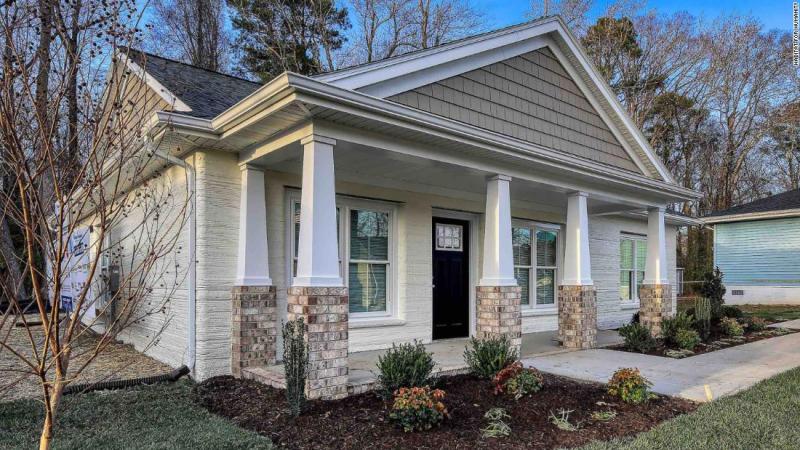First 3-D printed Habitat home in US arrives



(CNN)One Virginia family received the keys to their new 3D-printed home in time for Christmas.
The home is Habitat for Humanity's first 3D-printed home in the nation, according to a Habitat news release.
Janet V. Green, CEO of Habitat for Humanity Peninsula and Greater Williamsburg, told CNN it partnered with Alquist, a 3D printing company, earlier this year to begin the process.
The 1,200-square-foot home has three bedrooms, two full baths and was built from concrete. The technology allowed the home to be built in just 12 hours, which saves about four weeks of construction time for a typical home.
April Stringfield purchased the home through the Habitat Homebuyer Program. She will move in with her 13-year-old son just in time for the holidays. "My son and I are so thankful," Stringfield said in a live feed streamed on Habitat's Facebook page. "I always wanted to be a homeowner. It's like a dream come true."
To purchase the home, Stringfield logged hundreds of hours of sweat equity, Green told CNN, which is one of the requirements for homebuyers through the program. "Every Habitat affiliate in the nation and worldwide sells home to partner families who have low to moderate incomes," Green said. "They must have and maintain good credit and be willing to partner with us."
"I'm excited to make new memories in Williamsburg and especially in a house, a home," Stringfield told CNN affiliate WTKR. "Some place I can call home and give my son that backyard that he can play in and also for my puppy to run around the yard."
The concrete used in the house's 3D construction has many long-term benefits, such as the ability to retain temperature and withstand natural disasters, like tornadoes and hurricanes. Stringfield's home also includes a personal 3D printer that will allow her to reprint anything she may need, "everything from electrical outlet to trim to cabinet knobs," Green told CNN.
While this is the first 3D home for Habitat for Humanity in the US, it certainly won't be the last. Green told CNN it hopes to continue partnering and developing the technology used with the printing. "We would love to build more with this technology, especially because it's got that long-term savings for the homeowners," Green said.





I think this is pretty cool. Although it does make me wonder about the future of the trades.
I think this fills a nitch. People will always want a home with beautiful wood and stonework. For those who could never afford that, this provides an alternative.
To put up the basic structure that fast is impressive. Custom stone and woodwork can always be added after the fact.
Yes and this was entirely expected. We keep building bigger and better 3d printing machines using all sorts of materials (from bio to concrete). A few years ago I posted a seed on this featuring a 3d printed concrete bridge. Quite cool.
I have a 3d printer at home for printing plastic items. It is amazing how much utility we have exacted from this machine. I never would have thought it could be so useful.
Anyway, I think this is just the beginning. 3d printing (large scale) is going to be a mega trend.
I would love to be able to play with a 3d printer.....
There are a few tricks to get things to print well, but for the most part the printing is pretty easy.
The learning curve is more the software. The software I use is Fusion 360, MeshMixer and Prusa Slicer. Fusion 360 will be quite a challenge for those not familiar with CAD software.
But once one gets comfortable with the tools, it is amazing what can be done.
3D printing seems like the forerunner to Star Trek replicators. But this is still very cool. It voted change the construction industry.
I was saying the same thing last night to a friend of mine who is also into 3D printing.
Its a recurring pattern with Trek. The old style communicators of TOS was the forerunner to (now obsolete) flip phones. The PADD was a tablet and had wi-fi.
This is very interesting. I wonder what the cost is to actually build it. To be able to do it in 12 hours is amazing! That has to be some super quick drying cement
The material has to set up quickly based on the way 3D printers work. Each layer (Z axis) provides a foundation for the next layer so it has to set up to some degree before the machine makes its next cycle.
Got it. My son has 3D printers and can make some really nice things with them. I guess I was just surprised that concrete could set that quickly.
Yes, amazing the materials those chemists can produce.
I would imagine that the cost would have to be comparable at least, otherwise it wouldn't make sense for an organization like Habitat to use it.
They are an amazing organization. I hope this will help a lot more families in need without having to wait so long on a list.
I’m guessing those savings are mostly due to a lot less labor needed. Regardless 40% is a nice chunk of change to save.
That would be my guess too.
A 3D printed wall could have everything in place, plumb and square with preexisting conduits for running pipe and wire infrastructure and even insulated:
How cool is this.
Thanks, that was an informative video. I enjoyed it.
Very Cool! This will help out with affordable housing.
The world's first 3D-printed neighborhood is being built in Mexico for families living on $3 a day - CNN
I thought that his was especially interesting.
That must be very quick-drying cement. Most of the new homes in Florida are built with cement blocks for the same reasons mentioned in the article.
Yep, I would imagine it stays a lot cooler during the summer. And think of the money saved not having to go to Home Depot.
The roof trusses are wood and of course, the framing for the drywall on the inside of the block is wood. I can still find an excuse to visit Home Depot/Lowes or for recreation, ""Bass Pro Shops''...
They have been doing commercial buildings for around 7 years now, In the hobby world, I've moved from FDM to Resin 3D printing... FDM (Fused Deposition Modeling (FDM) Technology has been around since the late 80's .... It has developed to the point where it is cost effective to build houses with it, it's been used for commercial construction for over 20 years... Is it the wave of the future? That's not known yet.... Concrete has been around since the Egyptians were building pyramids (NO I'm not saying the pyramids were built out of concrete) This is just another way of forming it...
You can get into FDM printing now for well under $100.00, Resin printing for under $400.00...
Industry has been using FDM to print auto parts out of steel, Jewelry out of precocious metals, and there are whole factories using nothing but 3D printers in the plastics industries making everything from aircraft parts to coffee makers... In fact one of the biggest commercial 3D printer manufacturers does all their plastic parts on a factory floor full of their own brand of 3D printers...
This is just a logical extension of a long existing technology.....
Yep, this is pretty cool. IMO the 'printed' houses have some similarity to adobe construction. It seems that the more we advance, the easier it is to return to the past. I don't know if or how reinforcement is included so I wonder about long term maintenance.
I think everyone is overlooking the real implication of 3D printed construction. It's now possible to really build a man cave.
One only has to look at the Acoma Pueblo the oldest continually occupied village/town in the US over 1,000 years old and the building material used which is adobe.
Yep. When properly constructed an adobe building can last a very long time.
Or a she shed!
I've heard of a brick outhouse. But I've never heard of a cement she shed.
Back in the city in Ontario where I was born and grew up, when I was around 12 or 13 there was some disaster in Western Canada and to raise money a raffle was run for the sale of a home similar to the one in this article that all the building trades in my city got together and put up and completed in 24 hours (no 3D, just all the trades needed to complete the house). I rode my bike past it to go to school and I recall that in the morning it was already started, at lunchtime the walls were up, and when school was over the exterior appeared pretty well finished, and I guess the interior was completed that night. Of course it was a standard construction, and it seemed to be a pretty miraculous accomplishment back then, but then it was over 7 decades ago, and if 3D printing was even contemplated back then it was science fiction, like Dick Tracy's wrist cellphone or a sputnik in the sky.(although that DID happen around 6 or 7 years later).